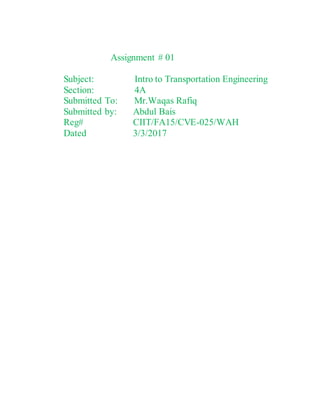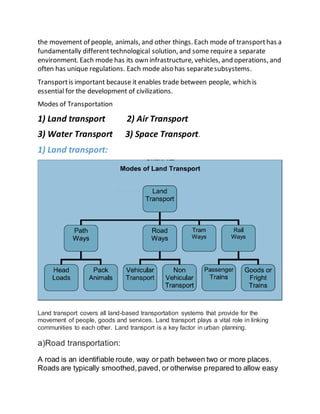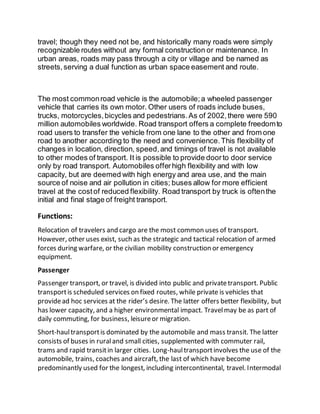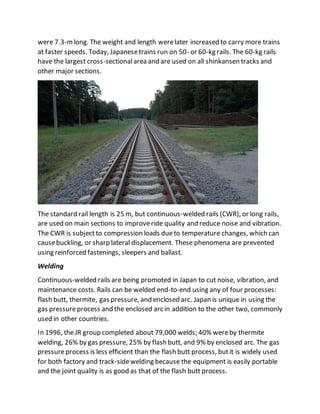This document provides information about various modes of transportation, their typical functions, and approximate range of capacities. It discusses the following modes of transportation:
- Land transport (road and rail transportation), which plays a vital role in linking communities. Road transportation includes automobiles, buses, and trucks. Rail transportation involves rolling stock running on tracks.
- Air and water transport. Air transport involves aircraft, while water transport refers to shipping.
- The document then provides more details on the capacities and functions of different modes, including passenger and freight transport capacities.






![engines. Mosttracks are accompanied by a signaling system. Railways area safe
land transportsystemwhen compared to other forms of transport.
Passenger trains:
A passenger train travels between stations where passengers may embark and
disembark. The oversightof the train is the duty of a guard/train
manager/conductor. Passenger trains arepartof public transportand often make
up the stem of the service, with buses feeding to stations. Passenger trains
providelong-distance intercity travel, daily commuter trips, or local urban transit
services. They even include a diversity of vehicles, operating speeds, right-of-way
requirements, and servicefrequency. Passenger trains usually can be divided into
two operations: intercity railway and intercity transit. Whereas as intercity railway
involve higher speeds, longer routes, and lower frequency (usually scheduled),
intercity transit involves lower speeds, shorter routes, and higher frequency
(especially during peak hours).
Intercity trains are long-haul trains that operate with few stops between cities.
Trains typically have amenities such as a dining car. Some lines also provideover-
night services with sleeping cars. Somelong-haul trains have been given a specific
name. Regional trains are medium distance trains that connect cities with
outlying, surrounding areas, or providea regional service, making more stops and
having lower speeds. Commuter trains servesuburbs of urban areas, providing a
daily commuting service. Airportrail links providequick access fromcity centers
to airports.
High-speed rail are special inter-city trains that operate at much higher speeds
than conventional railways, thelimit being regarded at 200 to 320 kilometers per
hour (120 to 200 mph). High-speed trains are used mostly for long-haulservice
and mostsystems arein Western Europe and East Asia. The speed record is 574.8
km/h (357.2 mph), setby a modified French TGV.[32][33] Magnetic levitation
trains such as the Shanghai airporttrain use under-riding magnets which attract
themselves upward towards the underside of a guideway and this line has
achieved somewhathigher peak speeds in day-to-day operation than
conventional high-speed railways, although only over shortdistances. Dueto their
heightened speeds, routealignments for high-speed rail tend to haveshallower
grades and broader curves than conventional railways.
Their high kinetic energy translates to higher horsepower-to-ton ratios (e.g. 20
horsepower per shortton or 16 kilowatts per ton); this allows trains to accelerate](https://image.slidesharecdn.com/dqmwpn1btqymhfkx3rka-signature-cada5187f505d495b4379c4048ecfd5b277bbeb9f725845c8550ea990068905f-poli-180104075533/85/Introduction-to-transportation-engineering-7-320.jpg)


![Bulk handling represents a key advantagefor rail transport. Low or even zero
transshipmentcosts combined with energy efficiency and low inventory costs
allow trains to handle bulk much cheaper than by road. Typical bulk cargo
includes coal, ore, grains and liquids. Bulk is transported in open-topped cars,
hopper cars and tank cars.
2) Air Transport: Air travelis a form of travel in vehicles such as helicopters,
hot air balloons, blimps, gliders, hang gliding, parachuting, airplanes, jets, or
anything else that can sustain flight.[1] Use of air travel has greatly increased in
recent decades - worldwideit doubled between the mid-1980s and the year 2000.
Air transportis an important enabler to achieving economic growth and
development. Air transportfacilitates integration into the global economy and
provides vital connectivity on a national, regional, and international scale. Ithelps
generate trade, promote tourism, and create employment opportunities. The
World Bank has financed aviation-related projects for over sixty years.
Functions:
Emergency Services:
Itcan operate even when all other means of transportcannotbe operated due to
the floods or other natural calamities. Thus, at that time, it is the only mode of
transportwhich can be employed to do the relief work and providethe essential
commodities of life.
Most Suitable for Carrying Light Goods of High Value:](https://image.slidesharecdn.com/dqmwpn1btqymhfkx3rka-signature-cada5187f505d495b4379c4048ecfd5b277bbeb9f725845c8550ea990068905f-poli-180104075533/85/Introduction-to-transportation-engineering-10-320.jpg)










